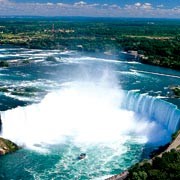Just like the catchy Wrigley’s Doublemint gum commercials that begged to “double double your delightment,” the Niagara region presents a double dose of excitement sure to surprise visitors with not only natural beauty, but cultural activities as well.
Straddling the Canada-U.S border, early settlers established homes on both sides of Niagara Falls, forming the neighboring cities of Niagara Falls, Ontario, and Niagara Falls, N.Y. And although the urban areas present different enticements, the falls remain the main draw.
“What attracts everyone to Niagara Falls is the great wonder of the falls,” says Paul Dyster, mayor of Niagara Falls, N.Y. “Niagara Falls is a great representation of how nature can co-exist with people. It is a very unique situation.”
Ranking up there with the Grand Canyon, Grand Tetons and even the Great Pyramid of Giza, travelers from all over the world come in droves to witness the destination’s beauty.
“I often find myself pinching myself to be living in the most beautiful place in the world,” says Ted Salci, mayor of Niagara Falls, Ontario. “Our population is only 82,000 people, yet we host more than 12 million visitors per year. On any given day, especially during the summer months, we have an additional 50,000 people in the city.”
While they may share the same natural wonder comprising three water falls—the American Falls, Bridal Veil Falls and the Horseshoe Falls—the two cities have charms all their own.
Just a few blocks from the falls on the New York side is Pine Avenue, dubbed “Little Italy,” which boasts a variety of shops and restaurants.
“The restaurants in Little Italy are of national stature,” Dyster says. “When you enter one of them you become one of the family and the owners never let you leave hungry.”
Dyster says Pine Avenue extends all the way to the scenic Niagara Gorge, with nearby attractions within close distance, such as the Niagara Gorge Discovery Center and the Aquarium of Niagara.
Also close by is the Seneca Niagara Casino & Hotel, which often brings in marquee entertainment acts.
“They have a great performance schedule,” Dyster says. “They bring in people you might not see outside of Las Vegas or New York City.”
Beyond its cultural highlights, Niagara Falls, N.Y., offers limitless hiking opportunities.
“When you get tired of the manmade cultural attractions or the flashing lights of the casino, you can just take a 15- to 20-minute walk down the gorge and be watching salmon jumping and just enjoy nature,” Dyster says. “It is like being on another planet. You would never believe that you are near a city. People love to take a bottle of wine and a picnic lunch down there and end up not wanting to come back.”
The area around Niagara Falls, N.Y., is also host to several scenic wineries as well as the Niagara Power Project’s Power Vista, another popular visitor attraction.
A short drive across Rainbow Bridge will land visitors in the bustling city of Niagara Falls, Ontario, a destination Mayor Salci says is growing by leaps and bounds.
“Niagara is undergoing a renaissance,” Salci says, adding that back in the early ’90s the area was plagued with unemployment, but after opening its first casino (Casino Niagara) in 1996, hotels, shops and restaurants soon followed.
“Since 1996 we’ve added 10 new hotels, lots of new attractions such as our butterfly conservatory and bird aviary, and new and improved dining options,” he says, adding that today, new hotels, shops and restaurants continue to pop up.
A relaxing day in Niagara Falls, Ontario, might include a stroll through Clifton Hill, an entertainment and dining district with museums, attractions and hotels.
While watching the breathtaking falls is always a favored activity, outdoor-seeking travelers can also hit the green at one of the area’s roughly 35 golf courses or take a bike ride along its miles of trails.
Just 21 miles north of Niagara Falls, Ontario, is Niagara-On-The-Lake, a quaint village filled with bed-and-breakfasts and wineries.
“This area is the Napa Valley of Canada,” Salci says. “We have phenomenal wineries.”






